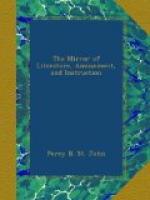In the churchyard are the tombs of Anthony Woodhead, 1678, who was in his day, the great champion of the Roman Catholic religion, and was reputed to have written the Whole Duty of Man; Lady Slingsby, whose name occurs as an actress in Dryden and Lee’s plays, from 1681 to 1689; Jeremy Collier, 1726, the pertinacious non-juror, who repressed the immoralities of the stage; Ned Ward, author of the London Spy, 1731; Leoni, the architect, 1746; Lady Henrietta, wife of Beard, the vocalist, 1753; Van Bleeck, the portrait-painter; Ravenet, the engraver, 1764; Mazzinghi, 1775, leader of the band at Marylebone Gardens, and father of Mazzinghi, the celebrated composer; Henry and Robert Rackett, Pope’s nephews; Woollett, the engraver, 1785, to whose memory a monument has been placed in the cloisters of Westminster Abbey; Baron de Wenzel, the celebrated oculist, 1790; Mary Wollestonecraft Godwin, author of a Vindication of the Rights of Woman, 1797; the Rev. Arthur O’Leary, or Father O’Leary, the amiable Franciscan friar, 1802; Paoli, the patriotic Corsican, 1807; Walker editor of the Pronouncing Dictionary; the Chevalier d’Eon, 1810, of epicene notoriety; and Packer, the comedian, 1806, who is said to have performed 4,852 times, besides walking in processions; Edwards, professor of Perspective, 1806; Scheemakers, the statuary, 1808.
In the Beauties of England and Wales, it is stated that 23 acres of land belong to the church; and the great increase of buildings renders these of considerable value; though it is not known to whom the church is indebted for this possession.
* * * * *
ELEGY.
From the German.
(For the Mirror.)
Through oak-woods green,
A silver sheen,
Sweet moon, from thee
Afforded me
A tranquil joy,
Me, then, a happy boy.
Still makes thy light
My window bright,
But can no more
Lost peace restore:
My brow is shaded,
My cheek with weeping faded.
Thy beams, O moon,
Will glitter soon,
As softly clear,
Upon my bier:
For soon, earth must
Conceal in youth my dust.
C.H.
* * * * *
CLEOPATRA’S NEEDLES.
(For the Mirror.)
These remains of ancient art are destined to be removed to Europe.[7] The palace of Cleopatra was built upon the walls facing the port of Alexandria, Egypt, having a gallery on the outside, supported by several fine columns. Towards the eastern part of the palace are two obelisks, vulgarly called Cleopatra’s Needles. They are of Thebaic stone, and covered with hieroglyphics; one is overturned, broken, and lying under the sand; the other is on its pedestal. These two obelisks, each of them of a single stone, are about sixty feet high, by seven feet square at the base. The Egyptian priests called these obelisks the sun’s fingers, because they served as stiles or gnomons to mark the hours on the ground. In the first ages of the world they were made use of to transmit to posterity the principal precepts of philosophy, which were engraven on them in hieroglyphics.




